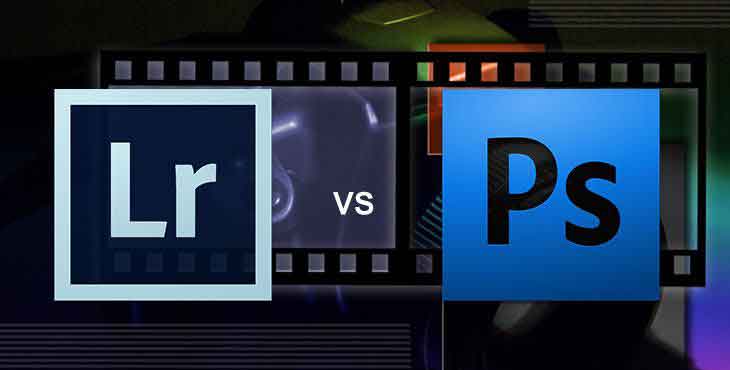Adobe Photoshop and Lightroom cc are indispensable editing tools for today’s photographers, architects, and graphic designers, though both serve different purposes. While Photoshop offers virtually unlimited image editing potential, Lightroom was created as more an image management system, though it does offer editing features as well.
The debate of Photoshop vs. Lightroom will come down to what features you are looking for. While Lightroom offers an excellent image management system and can process RAW files effectively with a more user-friendly RAW engine interface, Photoshop offers a superior image retouching experience, featuring tools like the spot healing brush and clone stamp. Each program has its pros and cons, depending on the scenario in which it is used.
Photoshop and Lightroom – An Overview
Adobe Photoshop
Popular among image editors and web designers, Adobe Photoshop is a user-friendly program which offers many unique tools and features. Most commonly used in editing digital photography, professional photographers often rely on Photoshop to make both basic and complex edits. Helping to accomplish tasks as small and simple as sharpening a photo to as large and complex as adding entire scenes to the background of other images, the possibilities while using Photoshop are almost endless.
Beyond photo editing, Photoshop is also used by graphic designers for creating things like business cards, website layouts, wedding invitations, art for digital books and publications and marketing materials.
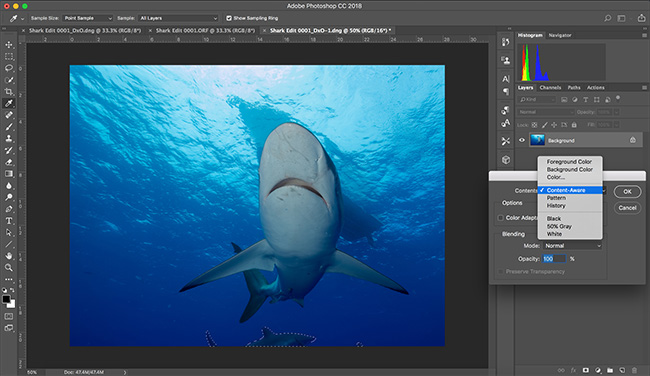
Lightroom CC
Adobe Photoshop Lightroom, or just Lightroom as it is more commonly known, is a family of image manipulation and organization software. With a smart way of linking images to catalog files, Lightroom offers lightning-fast access to RAW photos, and no need for saving, as all changes are saved automatically. It also offers several ways to add keywords for easy image management and geo-tagging with built-in Google Maps.
Though it doesn’t offer the range of image manipulation tools that Photoshop does, Lightroom has an intuitive editing interface wherein users can apply local changes by targeting specific areas of a photo.
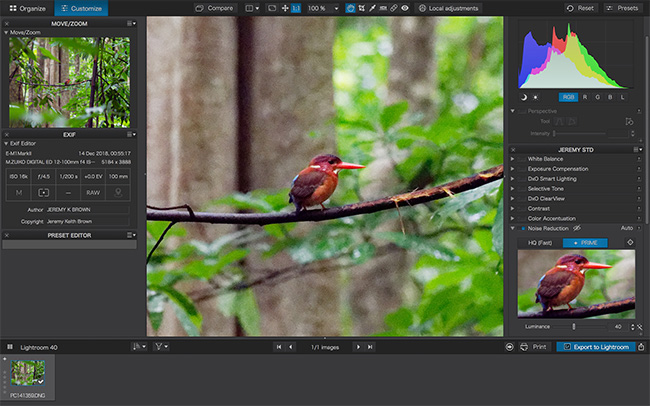
Comparing the Usage of Lightroom and Photoshop
When debating Lightroom vs. Photoshop, there is no simple right answer, as they are both great software packages which can bring out the best in your images. The choice between Lightroom vs. Photoshop needs to be addressed on a project-by-project basis.
Photoshop
- Images opened in Photoshop are comprised of pixels – the smallest points in a raster image and the smallest elements in a photo. Photoshop allows for editing at this level, offering almost limitless manipulation. Vector and raster images can be created in Photoshop from scratch.
- Photoshop allows for multiple layers within a master file, allowing for different images and edits on separate layers. These layers can be hidden, modified or enhanced independently
- A useful feature of Photoshop is actions, a series of steps that allow to create and record an entire editing process for automatic editing
- Another use for layers is Photoshop’s ability to blend and composite those layers, protecting specific parts of photos from adjustments being made
- Photoshop features may tool such as filters, automatic panoramic image stitching, content-aware filling and reducing camera shake effects
Lightroom
- One of Lightroom’s most useful features is built-in RAW editing with no plugin required
- Lightroom was built to give photographers a better photo library management tool and is based on creating a solid, consistent workflow
- Lightroom doesn’t have the huge array of tools that Photoshop does, making it easier to learn and with a much more simple interface
- Lightroom presets are strings of toning, contrast and exposure levels saved into a handy file, which can be applied to any photo with just a click of the mouse. These are shared online as well, giving photo editors unlimited options
- Lightroom editing is non-destructive because the original file never gets permanently changed, while Photoshop is a mix of destructive and non-destructive
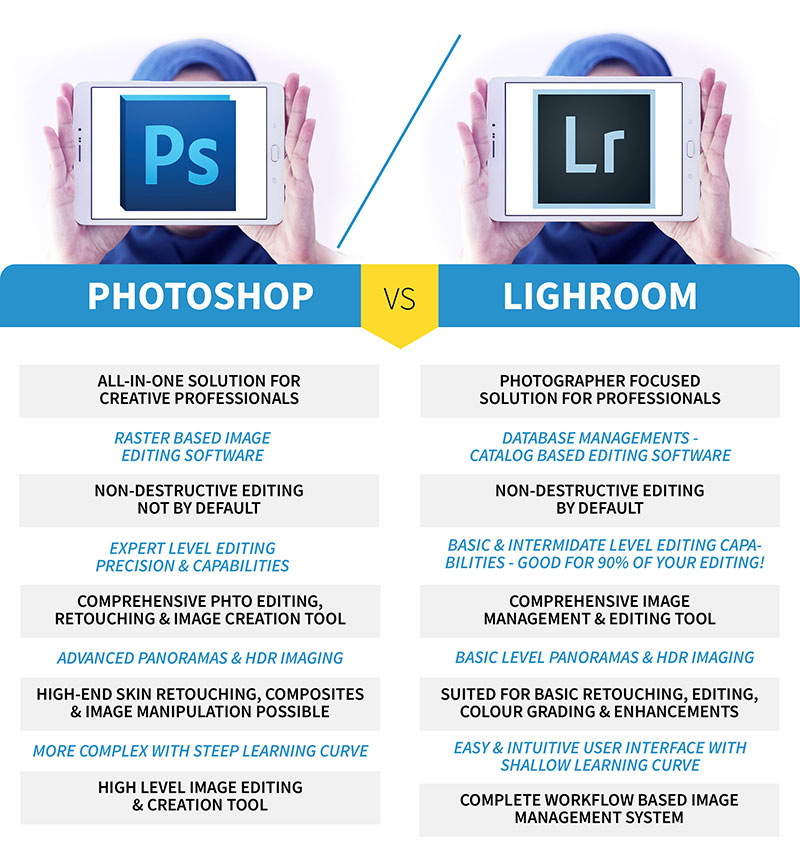
Photoshop or Lightroom – Which Is Better?
When discussing Lightroom vs. Photoshop, it’s important to remember that they are two very different programs. Lightroom is a much simpler and easier software to learn, but Photoshop is much more advanced and offers more features. Both have their strengths and weaknesses and deciding which to use will come down to the nature of the project you’re working on.
Feature-wise comparison of Photoshop and Lightroom
Adobe Lightroom
Lightroom is a lightweight and intuitive program with a host of features including:
- Lens and camera-based corrections
- Blurring and fixing tools
- Gradient adjustments and brushes
- Professional filters and present
- Face detection for photo organization
- Customizable sliders
- Multiple device support and sync
Adobe Photoshop
The go-to-tool for designers, illustrators, and artists, Photoshop offers some of the market’s most compelling retouching, layers, and masking tools, though basic touch-ups are often best handled by Lightroom. Some of Photoshops features include:
- Large amounts of brushes and filters
- Sophisticated retouching and touch-up features
- 3D design functionality
- Multi-layer editing
- Pro-editing tools
When to Choose What?
When to Use Photoshop
Photoshop is ideal for complex editing tasks, such as removing unwanted objects from images, compositing and blending or editing images with masks. When total, pixel-level control is required over an image, Photoshop should be the obvious choice. Not just for photo editing, Photoshop also offers many graphic-design features.
This complexity also means that Photoshop also has a higher learning curve, so Photoshop should be used when more control is needed and not just for basic touch-ups.
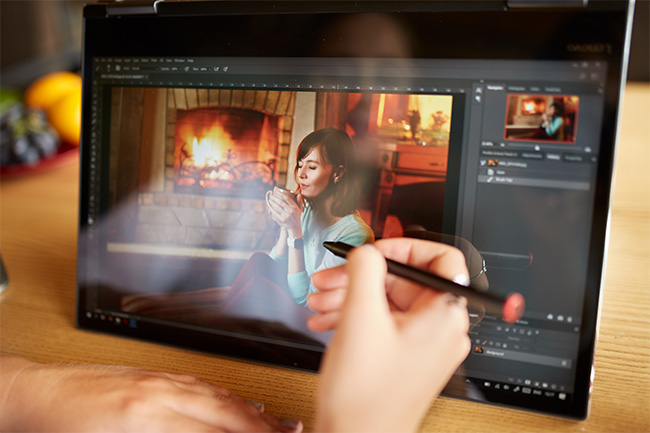
When to Use Lightroom
Lightroom allows for processing large numbers of photos in a short time frame. Lightroom presets allow for consistent post-processing by automatically applying the same adjustments to each image. Lightroom is ideal for projects when a smooth workflow is more important that pixel-level control over the editing of images.
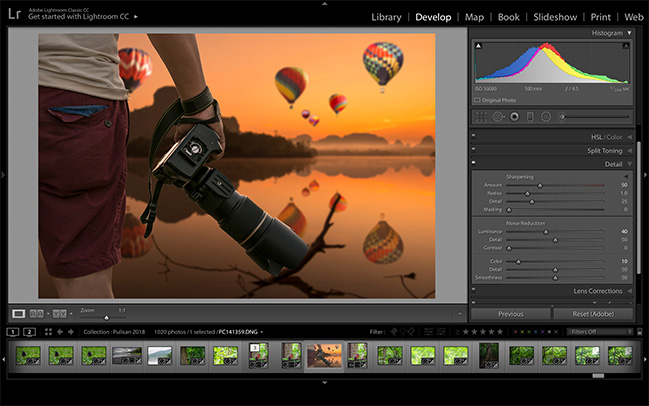
Lightroom Presets
Lightroom is not lightweight when it comes to image editing, mostly thanks to Lightroom presets which allow you to recreate an endless array of image styles, with thousands of presets also available for download on the internet. Another benefit of Lightroom is that there is no need for Adobe Camera Raw.
Lightroom has all the necessary tools for beginning photographers, such as white balancing, spot removal, cropping and color corrections.
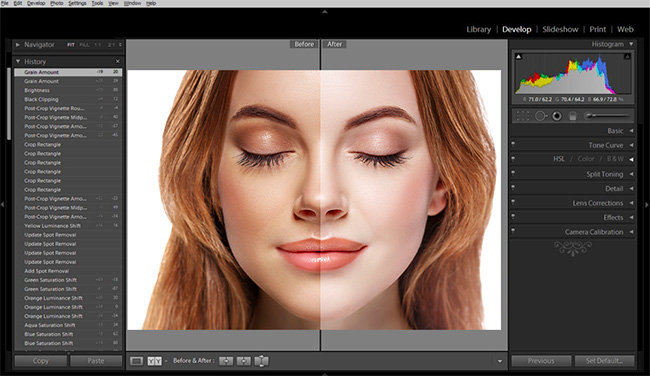
Integrating Adobe Photoshop and Adobe Lightroom
Integrating Adobe Lightroom and Photoshop can allow users to take full advantage of the capabilities of each program, such as using Lightroom for image organization and sharing, and Photoshop for more advanced editing. One click can send an image from Lightroom to Photoshop.
Lightroom’s external editing preferences will determine how files are passed from Lightroom to Photoshop, and you can specify the color-space, file format, and bit-depth, as well as the file-naming convention and how PSDs and other Photoshop files are displayed in Lightroom.
Let the Requirement Make the Decision
While Lightroom is certainly more affordable than Photoshop, each has its advantages and disadvantages, and both have a place in the post-processing workflow. Lightroom may be ideal for photographers with less intense editing needs, while Photoshop is ideal for those who take on more complex editing or retouching jobs.
Smart Photo Editors (SPE) boasts a team of experts with a keen eye for detail, along with quality infrastructure, advanced software, and state of the art technology – committed to providing world-class photo editing services to all of our clients. With experience handling even the most complex photo editing assignments from clients across Europe, the United States, Australia, and New Zealand, SPE is committed to making the lives of passionate photo professionals better with competitive pricing and strict quality controls on all projects.
– Smart Photo Editors
SmartPHOTOeditors
